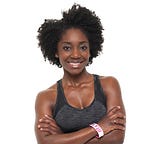The Benefits of Dynamic Stretching
Get loose with these 5 dynamic stretches before exercising to prevent injury
It’s probably safe to say that we all know what stretching is. It’s the series of movements we make when we lengthen our back, arms, legs, or neck, usually right when we’re just waking up or when we’ve been sitting for a long period of time, to loosen up our muscles.
This form of stretching is a type of static stretch. It’s when we move our muscles to the end of their range of motion and hold the position for a few seconds. Common static stretches include quad, hamstring, and posterior capsule or shoulder stretches.
Dynamic stretches are like static stretches but instead of holding a pose for a few seconds, you actively move your joints and muscles through a full range of motion.
Both types of stretches are great for the body because these movements increase flexibility and reduce the likelihood of injury. Stretching also improves circulation by increasing blood flow, which can reduce muscle soreness and shorten recovery times, in addition to boosting immunity (check out this video if you want to learn more). Improved circulation also has the added benefit of reducing tension and stress headaches which can help with other discomforts like ones related to the menstrual cycle.
While it’s good practice to stretch for at least 5 to 10 minutes before any workout, research shows that dynamic stretching may be better at loosening and warming up the body than static stretching. Researchers have also found that dynamic exercises are better for warming up our joints, which can further reduce the likelihood of injury. However, if you have mobility limitations or injuries, it’s best to check with a professional who can tailor your stretching and exercise routine specifically for your needs.
Now that you know the difference between dynamic versus static stretching, here are 5 dynamic stretches that you should do before your next workout:
Jumping Jacks
Start by standing upright with your legs together and your arms at your sides. Then bend your knees slightly and then jump into the air. As you jump, spread your legs outward so that they’re about shoulder-width apart while stretching your arms out and over your head. Then jump back into the starting position. Repeat 30 times.
Banded Glute Bridge
Start by lying on your back with your hands at your sides. Bend your knees and place your feet flat on the floor about hip-width apart. Squeeze your glutes and abs as you push through your heels to lift your hips off the floor. Your body should form a straight line from your shoulders to your knees when you’re fully extended. When your hips are lifted off the ground, squeeze your glutes again as you slowly lower your hips to return to the starting position. Repeat for 30 seconds.
Resistance bands are a nice way to ensure you have good form but you can still do the warm-up without one.
Squats
Stand upright with your feet about shoulder-width apart. Keep your back straight and begin bending your knees as if you’re about to sit in a chair. Your knees should be aligned with your toes and your weight so that you should still be able to see the tips of your toes as you squat. Another thing you want to do is shift most of your weight to your heels. As you return to an upright standing position, squeeze your glutes. Then repeat for 30 seconds.
If you’re just getting started, you may want to use a chair or stool as an aid, like in this modified version that I’m demonstrating below.
Mountain Climbers
Start by getting on your hands and knees as if you’re about to crawl. Place your hands shoulder-width apart and bring your knees and feet together while stretching out your body into a plank position. As you push up into a plank, keep your back straight and fix your gaze right in front of you so that you’re looking at the floor (not upward). This will prevent you from straining your neck and back. Keep your abs tight to ensure good form and bring each knee up as far forward as you can, as if you’re trying to kick your elbows. Repeat for 30 seconds.
Cheerleaders
Cheerleaders are like jumping jacks but instead of kicking both feet apart, you’ll alternate between kicking your left and right foot sideways. Stretch your arms out and over your head with each kick. Repeat 30 times.
